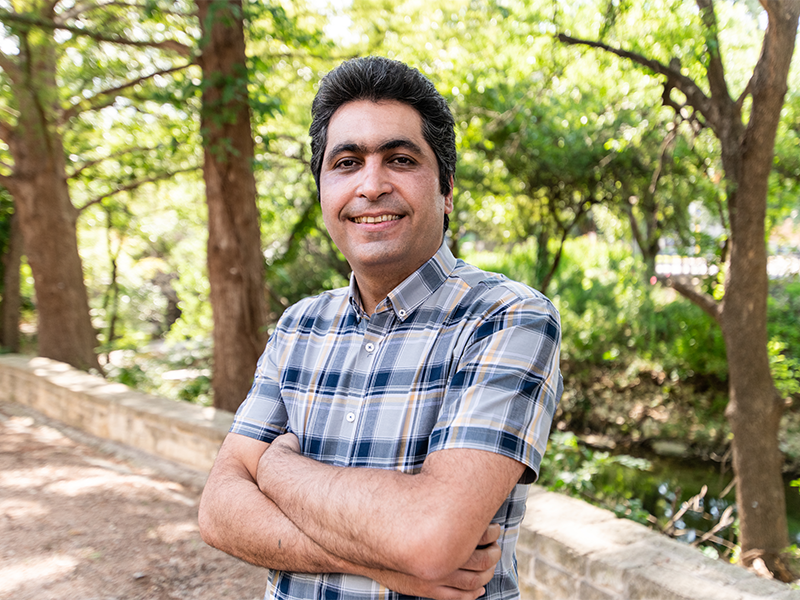Back to Faculty Directory

hadi.khani@austin.utexas.edu
512-471-4767
Office Location: ETC 9.108
Hadi Khani
Research Assistant Professor
Department Research Areas
Advanced Materials Science and Engineering
Dr. Khani is a Research Assistant Professor in the Walker Department of Mechanical Engineering and a core faculty member of the Materials Science and Engineering Program (MS&E) at The University of Texas at Austin since spring 2021. Before joining UT Austin as a faculty member, he had been a Research Associate at UT Austin (2018-2020) and a Postdoctoral Fellow at Notre Dame University (2017). Dr. Khani received his Ph.D. in Chemistry with a minor degree in Statistics at Mississippi State University in 2017, a master’s degree in Analytical Chemistry from Kharazmi University in 2009, and a bachelor’s degree in Chemistry from Arak University in 2007. Prior to his Ph.D., Dr. Khani had 2 years of industrial experience in the Research & Development Center for Chemical Industries, ACECR (2009-2011).
Dr. Khani has conducted research on broadly interdisciplinary projects across an extensive breadth of materials science and engineering including electrochemical energy storage, electrochemical sensors, electrocatalysis, electroplating, scanning electrochemical microscopy, material/polymer science, chemical extraction/separation, and chemometrics. The current research focus of Dr. Khani’s group lies in the design and synthesis of polymer and inorganic materials for use in rechargeable batteries, fast ion-conducting solid-state/gel electrolytes, electrocatalysts, and supercapacitors.
Selected Publications
- H. Khani, N.S. Grundish, D.O. Wipf, J.B. Goodenough, “Graphitic-Shell Encapsulation of Metal Electrocatalysts for Oxygen Evolution, Oxygen Reduction, and Hydrogen Evolution in Alkaline Solution,” Advanced Energy Materials, 10 (2020) 1903215.
- H. Khani, S. Kalami, J.B. Goodenough, “Micropores-in-Macroporous Gel Polymer Electrolytes for Lithium or Sodium Metal Batteries,” Sustainable Energy & Fuels 4 (2020) 177–189.
- H. Khani, J.F. Brennecke, “Hard chromium composite electroplating on high-strength stainless steel from a Cr(III)-ionic liquid solution,” Electrochemistry Communications, 107 (2019) 106537.
- H. Khani, D.O. Wipf, “Fabrication of Tip-Protected Polymer-Coated Carbon-Fiber Ultramicroelectrodes and pH Ultramicroelectrodes,” Journal of The Electrochemical Society 166 (2019), B673-B679.
- H. Khani, T.J. Dowell, D.O. Wipf, “Modifying Current Collectors to Produce High Volumetric Energy Density and Power Density Storage Devices,” ACS applied materials & interfaces, 10 (2018) 21262-21280.
- H. Khani, M.B. Sepehrifar, S. Yarahmadian, “An improvement on the prediction power of the 3D-QSAR CoMFA models using a hybrid of statistical and machine learning methods: a case study on γ‑secretase modulators of Alzheimer’s disease,” Medicinal Chemistry Research, 26 (2017) 1-17.
- H. Khani, D.O. Wipf, “Iron Oxide Nanosheets and Pulse-Electrodeposited Ni–Co–S Nanoflake Arrays for High-Performance Charge Storage,” ACS applied materials & interfaces, 9 (2017) 6967-6978.
- H. Khani, M.K. Rofouei, P. Arab, V.K. Gupta, Z. Vafaei, “Multi-Walled Carbon Nanotubes-Ionic Liquid-Carbon Paste Electrode as a Super Selectivity Sensor: Application to Potentiometric Monitoring of Mercury Ion(II),” Journal of Hazardous Materials, 183 (2010) 402–409.






